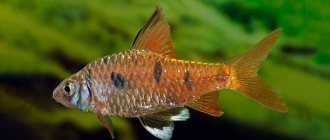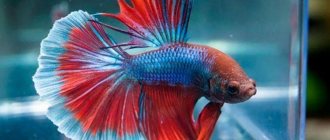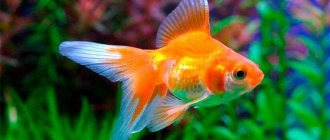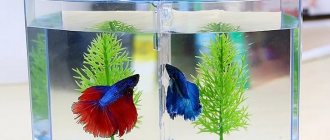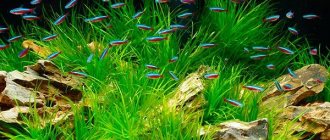The Sumatran Barb is an excellent option, as it is not difficult to keep and breed such fish. Belongs to the ray-finned class, the carp family.
It has a tall short body with a pointed head, length in an aquarium is up to 7 cm, but usually up to 4-5 cm, in the wild it can reach from 5 to 35 cm, depending on the species. These fish attract attention with their behavior and appearance. In character they resemble little bullies who constantly fuss and disturb the peace of other fish.
The color can be silver, yellow-red, golden-pink. There are 4 transverse black stripes running along the body, resembling a tiger. In an aquarium, the color of fish is brighter than in natural reservoirs. There are also albinos: the body is yellow or light beige, the stripes are milky.
Sometimes they freeze upside down at an angle of 45 degrees. There may be several reasons:
- Despite the constant rivalry, there is no clear leader in the group. Having lost the battle, the fish lowers its head to rush into the fray again;
- improper feeding. The fish were overeaten or the food was of poor quality;
- diseases (bacterial, fungal);
- lack of oxygen;
- accumulation of toxins.
Barbus comes from Southeast Asia, the islands of Sumatra, Borneo (representatives from these regions are found in aquariums). The range has spread to Singapore, Thailand, Australia, and the USA. Fish live in lakes and rivers with small currents. These fish are able to easily adapt and survive in new conditions.
Breeding forms with photos
Like most fish, in natural conditions barbs are rather inconspicuous - this is necessary for camouflage from natural enemies. Modern breeders have taken care of species diversity.
Subspecies differ from each other in coloring , but one thing remains the same - three contrasting stripes on the body and one on the head .
Dark green uniform
The mutant barb is dark green, the fins are black with an orange edging.
The dark green form also includes the “green tiger” subspecies. It has a pleasant golden tint and a light belly.
Albino
Albino fish have a light creamy body color, white vertical stripes, and transparent fins.
Platinum
This subgroup includes three types:
- Platinum barb. The body is white, the fins are black.
- Platinum. White with a golden tint, no stripes.
- Green platinum. White-blue hue with black fins.
Veiled
The subspecies differs from the classic form of fish by long fins of a red hue.
Glofish
Genetically modified subspecies of barbs. The body color is red or green, the vertical stripes are black. Otherwise, glos do not differ from ordinary Sumatran barbs.
Mossy
A dark green subspecies without vertical stripes on the body.
Black marble
Another subspecies of genetically modified fish. Their main difference is their black color and ability to glow in ultraviolet light. co
Interesting fact! The Sumatran luminous barb is prohibited for breeding, keeping and selling in some countries of the world.
Strawberry
The fish subspecies is albino, but has a delicate pink color.
Gold
Barbs have a creamy color with a golden tint. Albinos, which also include golden ones, are distinguished by their transparent fins and red head.
Habitat
The fiery barb has a fairly large habitat - the northeast and east of India. In addition, the fish is found in Afghanistan, Nepal, Bangladesh, and Pakistan. The barb has taken root well in some other countries where it was introduced artificially (Colombia, Mexico, Australia, etc.).
Stamp with the image of a fiery barb. Vietnam, 1987
On a note ! Depending on the geographic region, habitat conditions can vary greatly. The fish is found both in tributaries of rivers and fast streams, and in slowly flowing or even almost stagnant bodies of water.
Video – Fire Barb
Maintenance and care
Sumatrans are thermophilic; the optimal regime in the aquarium should be maintained at +24…25 °C .
Barbs, unlike other fish, are unpretentious, so water temperature is the only main condition.
To create comfortable conditions, periodic cleaning of the aquarium and constant aeration are necessary.
Water hardness should be from 6 to 10, acidity from 6.5 to 7.5 pH , good lighting is desirable.
View this post on Instagram
Publication from RYBKADOMA|Aquarium|Msk (@ribdom)
Feeding
Fish prefer natural food. They are fed once a day .
The ideal food for Sumatrans is dried daphnia, tubifex, bloodworms, finely chopped boiled squid is allowed .
Important! Barbs are quite gluttonous and can become obese due to overeating. Monitor the amount of feed.
Barbs also require plant food . Due to its lack, fish can damage aquarium plants by irreversibly plucking their leaves.
This need can be met by introducing plant-based dry fish food into the diet.
What to feed Sumatran barbs
This type of fish is omnivorous and constantly hungry. They eat well frozen and live food: bloodworms, daphnia, tubifex, brine shrimp. They will not refuse high-quality chips, cereals and even catfish tablets. They prefer to take food in the water column, but if necessary they eat well both from the surface and from the bottom.
It is imperative to include plant foods in your diet. These can be chips or tablets with spirulina, as well as pieces of cucumber, zucchini, lettuce, and nettle pre-dipped in boiling water. If there is a shortage of plant food, the fish will eat young shoots of plants.
Sumatran barbs are prone to gluttony. If you don’t control the amount of food, they feed, get fat and die. Therefore, food must be given in moderation. Once a day, preferably on the day of cleaning, you don’t have to feed the fish.
Compatibility with other types
Sumatrans are active and nimble, so it will be difficult for them to get along with sluggish species. You should not put barbs in the same aquarium with guppies, veil tails, or telescopes .
Sedentary fish in close proximity to Sumatrans risk being left without fins, as barbs love to bite them off.
Good compatibility with gouramis, tetras, parrots.
Advice! Barbs should not be kept in the same aquarium with large species of fish, as they may perceive Sumatrans as legitimate prey.
Behavior and Compatibility
The main rule of happy barbs: they must live in a flock of their own kind. The number of one species should be at least 5-6 individuals. Some representatives cannot live in less than a company of 15 people.
When selecting neighbors, you need to consider the following characteristics:
- The sizes of all fish in the aquarium should be approximately the same. Quantity too.
- It is better to plant different fish at the same time and at a young age, without introducing newcomers. If fish grow together, there is less chance that the territory will be redistributed.
- Barbs live mainly in the middle layer and closer to the bottom. This should be taken into account to avoid overpopulation of these areas of the aquarium. Fish that prefer to swim near the surface are well suited.
- Too active barbs can cause inconvenience to neighbors: they hunt for lush fins and long shoots, flicker in front of calm ones, chase leisurely ones. The temperament of neighbors must match.
- Barbs have no special means of defense other than swimming speed, so it is better not to share them with predators.
Reproduction
Breeding Sumatran barbs at home is accessible even to a beginner. Fish reproduce actively if optimal conditions are created.
Sex differences
The main difference between a female and a male is that they are smaller, their color is duller, and their fins are smaller. In addition, the head of males is purple in color.
In a separate spawning area
Spawning takes place in a separate small aquarium, where a mixed-sex pair of fish is first placed.
Advice! It is best to choose Sumatrans for breeding that have grown from fry in the same aquarium. In this case, the likelihood of successful spawning increases.
The water temperature during this period should be increased to +27 °C.
There should be a lot of plants in the spawning tank to create the necessary atmosphere ; the bottom must be covered with a loose nylon mesh so that the eggs pass through it freely.
It is important to provide good lighting. The female spawns at night and can release about 500 eggs at a time . At the end of the process, the parents are returned to the main tank.
Note! If the process of spawning has not begun after three days of fish being together in the spawning area, it is recommended to replace the male.
In the spawning tank with eggs, you need to completely turn off the lighting and aeration .
Then, within a few days, the fry begin to appear. Small barbs must be intensively fed with food rich in vitamin E.
In a common aquarium
Breeding fish in a common aquarium follows the same principle as in a separate spawning tank. It should be noted that with this method, half of the eggs can easily be eaten by other fish.
Mr. Tail recommends: variety of species
There are a lot of barbs in the wild, several hundred species, but every year new breeding varieties and breeds appear, more compact and brighter than those living in their natural habitat.
In the aquarium hobby, the number of species used to be about 15, but now there are many more.
Cherry Barbs
Fish of rich, bright, almost burgundy color are widespread in Asia and America. This fish loves the shaded water of streams and slow-moving rivers. Eats diatoms and invertebrates.
These small underwater inhabitants are up to 5 cm in length and always stay in a school.
In a single fish, the color quickly fades. She gets stressed and quickly dies or becomes overly aggressive.
Males are especially bright during spawning; they have a long dark stripe along their lateral line. They are slightly larger than females, but the latter have a larger abdomen. Easily reproduce in home aquariums.
Read more in the article about cherry barbs.
Fire Barbs
They are also called Red or Pink. Large individuals, up to 8-10 cm in length. Very active and mobile. Color pink with red highlights. They have no antennae, the fin plumage is transparent. They live for about 6 years.
There are several subspecies of the Fire Barb, living in Asia and South America.
Sumatran Barbs
One of the most famous and widespread species in the aquarium hobby, which is also called Tiger for its original coloring. Now there are many known breeds bred on its basis.
The species, found back in 1855, is native to Borneo and Sumatra. Lives in clean, air-saturated forest streams and is omnivorous.
It grows up to 7-8 cm and lives for about 7 years.
The fin is high, the head is pointed. The main background of the body is yellow or reddish, it is crossed by four wide black transverse stripes. Ruby and all fins.
The male is smaller and brighter; during spawning, his head also turns red.
During spawning, a female is capable of laying up to 700 eggs. Juveniles grow very quickly and reach sexual maturity already at 2-3 months with a size of 2-3 cm. Very hardy fish with good immunity.
They should only be kept in a flock of 6 or more individuals; individually they become very aggressive.
Barbus Mutants
Or Mossy, selection forms grow up to 7-8 cm, live about 5 years.
It has black plumage with red edging and a bluish, violet, lilac, pinkish tint of the body when rays of light hit it. It was the multicolor color that gave the name to the Mutant breed; because of this feature, the pet’s immunity is significantly reduced.
Shark Barbs
In nature, they live in the reservoirs of Thailand, Cambodia, and Sumatra. They have dimensions of 25-30 cm, silvery scales, large dark eyes and sharp plumage, reminiscent in appearance of shark fins.
Despite their colorless color, the scales have a mirror effect; any other inhabitants of the reservoir appear pale against the background of these pets.
Baloo sharks are large fish, they are very mobile, need a lot of free space, are active, but shy. You need to provide a lot of hiding places for them in the aquarium. They live up to 10 years.
Four-band Barbs
They are quite rare in home aquariums and there are no cases of their sustainable breeding in captivity yet.
Often sold together with the Tiger Sumatran Barb, as they have some similarities in appearance.
The homeland of the species is Asia, Vietnam, Cambodia, Laos, Thailand. The fish is about 4 cm in length. The main background is silver, with four wide stripes of dark color running along the body. The fin plumage is almost completely transparent with a red dot on the back.
Omnivorous and unpretentious schooling fish.
Two Point Barbs
This species naturally lives in water bodies of India and Sri Lanka. Loves small and medium-sized rivulets and streams in mountain tropical forests.
The natural population has declined greatly in recent years due to human activity and the massive catching of fish for sale.
They grow up to 5-6 cm. Males are slimmer and brighter than females. A red stripe of varying degrees of intensity and two dark markings are visible on the silver body.
Cross Barbs
Or Lateristriga, grow up to 12-13 cm and require a large tank to be kept in a flock. A beautiful reddish tint is visible on the green back, the sides are shiny brownish-golden. There are two dark wide stripes along the upper part of the body, and a dark blue line at the bottom, which tapers to a red tail.
This is an Asian species that prefers to live in clean river channels. Sometimes found in the area of peat bogs, due to the high concentration of tannins in the water, the main background of the body is almost brick-like, similar to strongly brewed tea.
A very active and noisy fish that reproduces well in a home aquarium.
Barbus Oligolepsis
They are an endemic species of Sumatra, living exclusively in Lake Menue, the crater of an exploded volcano. The fish are not caught in natural conditions, but are grown on Asian fish farms.
These are miniature barbs, rarely growing up to 4 cm (females). Males are smaller and brighter. Their color is dominated by pinkish and lilac tones, and the high red plumage has a black border.
Barbus Denisoni
It got its name in honor of the colonial governor of India in the 70s of the 19th century, William Thomas Denison.
Endemic to the South Indian Western Ghats mountain range. Lives in the upper reaches of rivers and creeks.
For many years this species was actively caught for sale and is now on the verge of extinction. Exports from India are limited.
The length of an adult individual is 11-12 cm, the slender silver body is crossed out by a black longitudinal stripe with a ruby streak in the upper part of the body. The fin on the back is red, and the tail feathers are transparent, charcoal yellow.
The peaceful fish feels good in a spacious tank in a school of 6-8 individuals. In smaller numbers, pets are shy and hide in algae.
It is very difficult to reproduce in aquariums; only isolated cases are known. Mostly they are bred using hormonal therapy on fish farms in Thailand, Singapore, and Malaysia.
This fish is also called Bloody Eyes and Miss Kerala.
Indian Barbs
They are not always distinguished as an independent species, since some ichthyologists consider them to belong to the Striped Barbs.
Asian and West Indian species (Goa, Kerala, Karnataka). It lives in shallow rivers, covered with leaves and tree branches.
Adults grow up to 7-8 cm. The back is reddish or orange, the belly is light and silver. A wide transverse black stripe runs down the middle of the body. Sometimes there are two or three.
A calm and peaceful fish in a school of 8-10 specimens. It reproduces well in a home tank, does not form clutches, but scatters eggs throughout the soil of the aquarium.
Exclamation Barbs
In the scientific world they are called Dawkinsia exclamatio, named after the Englishman Richard Dawkins. Actually, “exclamatio” means an exclamation mark. It is reminiscent of an individual in an upside-down state (dark streak at the tail and black eye).
An endemic species of Ashtamudi Lake, located in southern India. It is also found in clear mountain rivers flowing into it. In the reservoir itself it lives in coastal silted zones.
The large (up to 10-11 cm) fish has a very provocative and expressive coloring. Perhaps its name is caused by the exclamation at the first glance at this truly multicolored fish. It seems that bright large strokes are scattered in disarray throughout the body. The pattern of each specimen is unique, but there is always a long black streak at the base of the caudal fin.
Males are slightly smaller and brighter than females, and during the mating season, peculiar growths appear on their heads.
A very peaceful schooling beautiful fish. It reproduces well, but many fry die, since the parents do not show any care for the offspring.
Barbus Stolichki
They got their name from the Czech (Moravian in the 19th century) ichthyologist Ferdinand Stolichka, who studied the Indochinese fauna.
Outwardly they are very similar to Barbus Tikto, they are often confused.
The main background is light or dark silver with clear longitudinal markings on the caudal fin and head.
Males have very colorful fins on the back and chest - black and red, the rest and all of the females are transparent and inconspicuous.
They grow up to 5 cm, reproduce well in captivity, and live in flocks.
Odessa Barbs
They got their name not because of their habitat. It’s just that the first aquarium specimen was sold from Odessa only in 2003. And the birthplace of the fish is Myanmar, the Chindwin River with very hard calcareous water.
A strong, dense fish body in reddish-golden tones. An orange wide longitudinal stripe runs from the eye to the tip of the tail on both sides, and the rest of the radiant plumage is yellow and black.
The size of individuals does not exceed 4-5 cm; there are also transverse sparse bluish stripes or dots on the body.
Barbus Arulius
South Indian type of Barbus, in some places almost completely disappeared from the wild.
The powerful wide body (up to 10 cm long) has a pale color in pinkish, lilac, golden tones, it is crossed out by impressive transverse stripes of a dark color. The fins, especially the tail, are red.
Very active schooling fish that reproduce well in captivity.
Barbus Clowns
These Asian underwater inhabitants also have other names - Everett's Barb or White Clown.
This name gave rise to a bright color that really resembles a clown outfit. The large body reaches 10-11 cm when kept in an aquarium; in nature the fish is larger. The body is like a torpedo in shape and speed of movements.
The color is reddish-golden with black sparse transverse stripes, the fin plumage is especially bright - almost orange.
They live for about 8 years. Sexual dimorphism is practically absent. The female reaches sexual maturity by 12 months, the male by 18. If the difference between the partners is more than 2 years, then mating becomes impossible.
Five Striped Barbs
They are endemic to Borneo, this island is located in Malaysia. Most often lives in peat bogs and streams flowing from them.
The fish is small, up to 5 cm, males are more graceful and expressive. The body is painted in red-copper tones with five transverse wide black stripes.
This species has its own variety - the Six-Striped Barb, except for the number of markings, the coloring and body shape of the individuals are identical.
Five-line or Striped Barbs
They differ from the previous variety in that the stripes on the grayish-olive or golden-pinkish body are located not across it, but along it.
This Asian species is large, the fish grow up to 12-13 cm. They reproduce well in captivity.
Green Barbs (Puntius)
A subtropical natural species inhabiting the reservoirs of the south-eastern parts of Asia, which are often also called Chinese Barbs.
They grow up to 7-8 cm, life expectancy is about 7 years.
The body is tall and strong with a bluish-green color with a metallic sheen, the plumage is reddish along the edges. There are no characteristic transverse stripes.
When the fish reaches 2-3 cm in length, it is ready to mate. The male's head turns red.
Schubert Barbs or Golden Barbs
This is a completely selective species obtained by crossing Green Puntius or Barbus. The breed was registered by the American breeder Thomas Schubert.
It is essentially a golden (yellow) mutation of the Green species. The background of the elongated spindle-shaped body (up to 8-9 cm) can be golden-lemon, straw to light orange shades. The fin plumage has a reddish tint, not too frequent dark markings of varying sizes are scattered across the scales, each plate has a coal edge. Large eyes and short whiskers complement the appearance of this pet, which lives in the aquarium for about 3-4 years. The immunity of the mutating species is somewhat reduced.
Females and males are almost impossible to distinguish. Males during the spawning period look a little slimmer and brighter.
Barbs Butterflies
Or Moths - an African species that inhabits the right tributary of the Congo, the Mongala.
These are small fish (up to 3 cm) of pinkish-silver color with yellow plumage. There are several sparse and large black markings on the body.
Males and females are practically indistinguishable in appearance.
In nature they breed twice a year during the rainy season. The same breeding pattern is maintained in home aquarium keeping.
Albino Barbs
Also artificially bred on the basis of the Tiger Sumatran Barb.
The body is light in color - from pale lemon to light peach. This breed is often called Platinum or Golden Tiger Barbs.
Pets grow up to 7-8 cm and live in the aquarium for 6-7 years.
During the mating season, females become heavier due to their expanding abdomen, and males are brighter and have red spots on their heads. With a growth of 3 cm, the fish are already ready to mate.
Sunny Barbs
They are often called Golden Dwarfs for their small size (rarely growing up to 4 cm) and golden body color with rare wide black strokes at the base of the entire fin plumage.
The fish’s homeland is the Ganges River; now, in addition to India, it is also found in Bangladesh and Nepal.
These are extremely timid pets that, without a flock of 8-10 individuals, will simply die from stress. They reproduce well at home.
Red-tailed Barbs
This is a large Asian species (Mekong, Chao Phraya, Mun rivers).
In an aquarium they can reach sizes of 20 cm; in their natural habitat, individuals are larger. Life expectancy is about 10 years.
Has a very high back. The body is painted in silver or golden tones, and the plumage and especially the caudal fin are red.
To keep them at home, you will need a large aquarium, since a flock is required; individual individuals are very stressed.
Reproduction in captivity is almost never successful. Pet stores sell fry raised on Asian fish farms.
Cuminga barbs
They are an endemic species of Sri Lanka, living in only two rivers, Kepani and Kalu. The first is inhabited by a fish with red plumage, the second with golden ribs. The underwater inhabitants of their native habitat are becoming more and more inconspicuous every year. Massive harvesting for sale, massive deforestation and pollution of water bodies have caused irreparable harm to the Kuminga population.
Males are smaller and much more expressive than females. But their sizes rarely reach 5-6 cm.
The redfin variety is very rare and highly prized.
Both subspecies have dark markings on the gill covers.
Diamond Barbs
A medium-sized Asian type, endemic to Borneo, inhabitant of peat bogs and streams flowing from them.
They reach 5 cm in length, have a pinkish-golden iridescent body with 3-4 strokes of a dark diamond-shaped color.
They are most beautiful in dim lighting; in bright light they become pale and silvery.
Tikto barbs (scarlet)
Widely distributed in Hindustan - India, Pakistan, Nepal, Bangladesh, Bhutan, Sri Lanka. They love small streams and rivulets with a silted bottom covered with fallen leaves.
Adult specimens reach 6 cm in length. The main background of the body is orange-red or pink.
There are usually two large markings on the scales - near the gills and at the base of the caudal fin.
Read more in the article about scarlet barbs.
Barbus filamentosa
An Indian variety found primarily in Kerala. Selects swampy areas in the floodplains of small rivers.
Large individuals grow up to 12-13 cm and require a large tank of at least 400 liters for a flock of 4-6 individuals. Very mobile and active.
The body is silver with a pinkish tint and a large black marker located closer to the base of the tail. The fins on the back are strongly raised and clearly defined, resembling feathers or threads.
Black Barbs
Or Purpleheads are an endemic species of Sri Lanka, found in clear forest streams. The natural population is in severe decline, as less than 5% of the tropical jungle remains on the island.
A very beautiful and bright fish, in great demand among aquarists. Massively produced in Asian fish farms.
The strong, laterally flattened body is colored blue-pink, lilac, violet and crossed out by wide black transverse stripes. They grow up to 6-7 cm, males are more graceful and brighter than females.
During the mating season, males acquire a purple head color, and the scales on the body become almost charcoal, since each plate is equipped with a black edging. The females do not resemble them at all - they are pale yellow.
Stiff-lipped Barbs
Asian large fish (up to 30-35 cm), included in the list of commercial fish in some countries. They live in small rivers of Thailand, Laos, Cambodia, Vietnam, Borneo, Sumatra, Java.
A strong, powerful, elongated body of a silver color, but on each scale there is a dark dot, so the fish appears to be covered with horizontal stripes. High plumage with a pinkish tint.
It has several subspecies, slightly different in color tones.
Sexual dimorphism is practically absent. It is impossible to distinguish between female and male individuals.
They are very voracious, with their large strong lips they scour the entire bottom in search of food, even eating algae.
A single fish will be highly stressed, so the aquarium of these shy giants should contain at least 5 individuals, and its volume should be at least 600 liters.
It is almost impossible to obtain offspring at home. For commercial purposes, Stiff-Lipped Barbs are bred on farms in Thailand, Vietnam, Singapore, and Malaysia.
Dawkins Barbs
These fish are also called shaded fish. The species was discovered by English biologist Richard Dawkins, who was exploring Indian biotopes.
There are several subspecies that live in clear mountain streams with a rocky bottom and oxygenated water, and inhabitants of lowland rivers in which muddy water flows very slowly.
A very beautiful fish, growing up to 10-12 cm and intricately colored. It seems to consist of two parts - the upper one is very bright, golden with a scarlet dorsal fin. The semicircular border in the middle of the body is marked with a red dotted line; there is the same edging on the scales. But the lower part of the body is white with a slight pinkish tint. There is a large dark mark near the base of the caudal fin and a blue neon smear on the gill slit.
The tips of the two-lobed large caudal fin in males have bright red and black markers.
Raising fry
The process of development of a barb fry into an adult takes about 4 months. Young fish are capable of reproduction at the age of 5–6 months .
The fry must live in a separate aquarium until they reach maturity. During this period, the juveniles receive increased nutrition with live, plant food.
“Newborn” fry have a nondescript silver color. The characteristic olive color and stripes appear in fish closer to 2 months of life.
Description and features
The natural habitat of barbs is the waters of the islands of Sumatra and Kalimantan. In the first half of the twentieth century, the fish was brought to Europe and was liked by local residents.
Sumatrans are characterized by a short, tall body, slightly flattened laterally. The color is olive, with a pink or red tint. From the back to the abdomen, several wide black stripes with a greenish tint run across the body.
The fins are black with a red edging, or completely colored bright red. It is not difficult to distinguish a male from a female, because they are much slimmer and brighter. In addition, the edging of the tail and the head of the male have a purple tint.
The average size of an adult is 5-7 cm.
It is not difficult to distinguish a male from a female, because they are much slimmer and brighter. In addition, the edging of the tail and the head of the male have a purple tint.
Barb diseases
How long do Sumatran barbs live in an aquarium? The average lifespan of fish is 4–5 years .
Some diseases can lead to the premature death of all living creatures in the aquarium, so their occurrence must be prevented and treated in a timely manner.
Digestive problems
Sumatrans are voracious, the key to a long life is control of feeding . Too frequent, excessive feeding leads to obesity and then death of fish.
Symptoms of excess weight:
- the fish becomes apathetic and slow;
- the abdomen noticeably increases in size.
To reduce body weight, it is recommended to first exclude food for several days so that the barb begins to use its own fat deposits.
Then you should review the feeding diet and reduce the portion size.
Ectoparasitic diseases
Toxins released by protozoan microorganisms can harm barbs.
For treatment, it is necessary to dissolve the drugs “Biomycin” and “Bicillin” in water. The course of treatment is 5–7 days.
About barbs
Barbs are freshwater fish that are found in the wild of Africa and Southeast Asia. There are more than two thousand wild and artificially bred species of barbs. The genus Barbus belongs to the Karpov family.
A school of young sharks. When these fish grow up, they will become the largest representatives of the barb family.
All types of barbs prefer to live in flocks of at least 6 individuals. If you keep barbs alone, they become aggressive. It is better to choose active fish of approximately the same size as neighbors.
Barbs can jump out of the aquarium. Therefore it must be equipped with a lid. It is better to choose a rectangular long container in order to fully enjoy the active games of your pets. Some species prefer running water; they need to organize an artificial flow.


